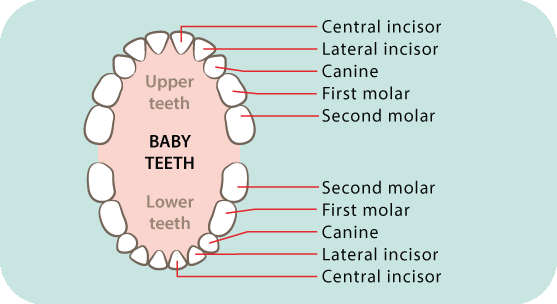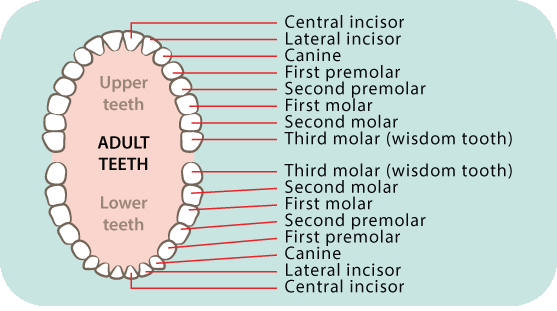Teeth development in adolescence
Between 6 and 12 years, children have a mixture of adult and baby teeth. By the age of 12, most children have all their adult teeth except for their third molars (wisdom teeth). There are 32 adult teeth.
When adult teeth are coming through
Your child might find chewing is more difficult when their baby teeth are loose or missing, but your child still needs to eat healthy foods.
It’s important for your child to keep up their teeth-brushing routine, taking extra care around loose baby teeth or sensitive areas.
Sometimes an adult tooth will come through before the baby tooth has fallen out. If the baby tooth hasn’t fallen out within 2-3 months, see your dentist.


How to take care of children’s teeth at 9-11 years
Brushing teeth is important for keeping teeth clean and preventing bad breath, tooth decay and gum disease. At this age, your child probably doesn’t need your help to clean their teeth anymore. But if your child needs a reminder, here are the basic steps:
- Use a pea-sized amount of regular adult fluoride toothpaste.
- Aim the toothbrush at a 45° angle to the gumline. If you’re using a manual toothbrush, move the brush in small, gentle circles. If you’re using an electric toothbrush, move the brush gently across the teeth, spending a few seconds on each tooth.
- Start with the top teeth. Brush the outside surface of the teeth and along the gumline, one tooth at a time. Then brush the inside surface of the teeth and gums, one tooth at a time.
- Move to the bottom teeth and repeat the step above.
- Brush along the chewing surfaces of the teeth.
- Gently brush the tongue.
- Brush for around 2 minutes.
- Spit out the toothpaste as you clean. There’s no need to rinse with water. Any leftover fluoride toothpaste helps to build strong, healthy teeth.
If your child’s teeth sit tightly against each other, your child can use waxed dental floss to clean between their teeth once a day. Your child might still need your help to do this.
How to choose toothbrushes and keep them clean
Choosing a toothbrush
When you and your child are choosing a toothbrush, you can look for the following:
- Soft bristles – these won’t damage your child’s gums or the surfaces of your child’s teeth.
- A small head – this will make it easy for your child to move the toothbrush around their mouth, one tooth at a time.
Electric and manual toothbrushes are equally good if your child uses them properly to clean all the surfaces of all their teeth. Electric toothbrushes can be useful if your child has difficulty with hand control. If you’re deciding between a manual and an electric toothbrush, it’s OK to let your child choose.
Keeping the toothbrush clean
You can remind your child to rinse the toothbrush with tap water after cleaning their teeth and gums. And your child should store the toothbrush upright in an open container to allow it to air-dry.
It’s a good idea to change your child’s toothbrush every 3-4 months or when the bristles get worn or frayed.
Fluoride and dental health
Fluoride is a mineral that keeps teeth strong and prevents tooth decay. Fluoride is safe and works best when your child gets it in very small amounts throughout the day from the following sources:
- Toothpaste – at this age, your child can use regular adult fluoride toothpaste.
- Tap water – most tap water in Australia has added fluoride.
For children who are at high risk of developing tooth decay, dentists might also prescribe gels and pastes with extra fluoride.
Diet is an important part of preventing tooth decay. Encourage your child to eat healthy, low-sugar foods and drinks, and help your child to develop healthy eating habits.
Dental sealants
Your dentist might recommend dental sealants for your child.
Dental sealants are thin, plastic coatings that stick to the chewing surfaces of teeth. These sealants stop plaque build-up in the grooves of teeth, which helps to stop tooth decay. Applying the sealants is usually simple and quick, with very little discomfort for your child.
Sealants don’t stay on your child’s teeth forever. They might sometimes need fixing or replacing. Your dentist will check them regularly.
If you’re interested in dental sealants for your child, speak to your dentist.
Visiting the dentist: a key part of dental care
Your child should visit the dentist regularly, even if you think your child’s teeth are healthy. Talk to your dentist about how often your child needs a check-up. Dentists usually recommend every 6-12 months.
Depending on your child’s needs, your child might also see other dental health professionals like dental therapists, dental hygienists, oral health therapists, paediatric dentists or orthodontists.
Dental care for children in Australia
In Australia, children can get dental care in the public system or private system.
The public dental health system provides basic dental care, which is often free or subsidised.
The private dental health system provides both basic and specialist dental care. This usually costs money. Private health insurance and other schemes might partly cover the cost of private dental care.
If you’re eligible, the Australian Government’s Child Dental Benefits Schedule covers basic dental care for children aged 0-17 years at most private and public dental services.
You can visit your state or territory health department website or Teeth.org.au – Government dental care to find out about public dental services near you. You can also search online to find private dental services near you.